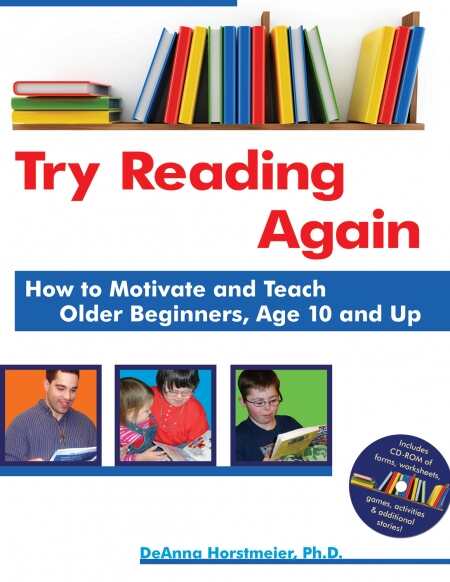
Try Reading Again
How to Motivate and Teach Older Beginners, Age 10 and Up
- 2012 INDIES Winner
- Honorable Mention, Education (Adult Nonfiction)
DeAnna Horstmeier is a highly qualified educator with vast experience working as both a special education teacher and a consultant. In teaching children with moderate to severe disabilities, including Down syndrome and Autism Spectrum Disorders, Dr. Horstmeier has developed her own approaches to instruction, finding new methods that have proven successful for her students. In a previous book, Teaching Math to People With Down Syndrome and Other Hands-On Learners, she presented her ideas about teaching relevant math skills, focusing on their applications in everyday life. Her newest book, Try Reading Again, offers a method of teaching reading that is meant to make reading both easier and more appealing to students struggling with traditional teaching styles. Not exclusively for disabled students, Horstmeier’s teaching method is effective for those challenged with English as a second language and for older students who never developed solid reading skills in the classroom.
The core of the method presented in Try Reading Again is Horstmeier’s Triangle Approach. Her strategy involves three components—the base and sides of her triangle—addressed simultaneously and approached in increasing levels of age-appropriate difficulty. “Older students are ‘turned off’ by reading materials that are aimed at young children,” she asserts, adding that keeping students motivated is essential to their learning.
The book addresses incorporating the Triangle Approach into existing school programs, stressing that “a combination of philosophies” has been shown to be most effective in teaching reading. “This approach is not totally whole language, phonemic awareness, or phonics,” Horstmeier explains. Her method is flexible, and teachers, tutors, and parents who implement it are encouraged to tailor its components to suit the individual student. Each of its three major sections is presented at three different skill levels, and the program accommodates the student whose ability is higher in one area than another.
Try Reading Again is an all-inclusive manual. In addition to outlining her technique, the author provides clear procedural guidance, with individual lessons, student worksheets, activity and game pages, and more. An included CD-ROM offers access to additional forms and worksheets, as well as some extra material. Knowing that some students respond especially well to computers, she suggests using the online Starfall group of computer programs in conjunction with her book, and she recommends specific activities to try on the site.
Dr. Horstmeier quotes some very frightening statistics, indicating that national reading tests for 2009 showed that 68 percent of America’s public school fourth graders were not “proficient” in reading. Considering that reading skills are rarely taught in school much beyond that grade level, many students will never become proficient readers, and the increasing need for programs like hers becomes glaringly evident. The practicality of her teaching approach, her hands-on instruction, and her expert advice are refreshing and appealing. Try Reading Again is clearly written and well organized, and there seems little downside to giving the book and its approach to reading a try.
Reviewed by
Cheryl Hibbard
Disclosure: This article is not an endorsement, but a review. The publisher of this book provided free copies of the book and paid a small fee to have their book reviewed by a professional reviewer. Foreword Reviews and Clarion Reviews make no guarantee that the publisher will receive a positive review. Foreword Magazine, Inc. is disclosing this in accordance with the Federal Trade Commission’s 16 CFR, Part 255.
